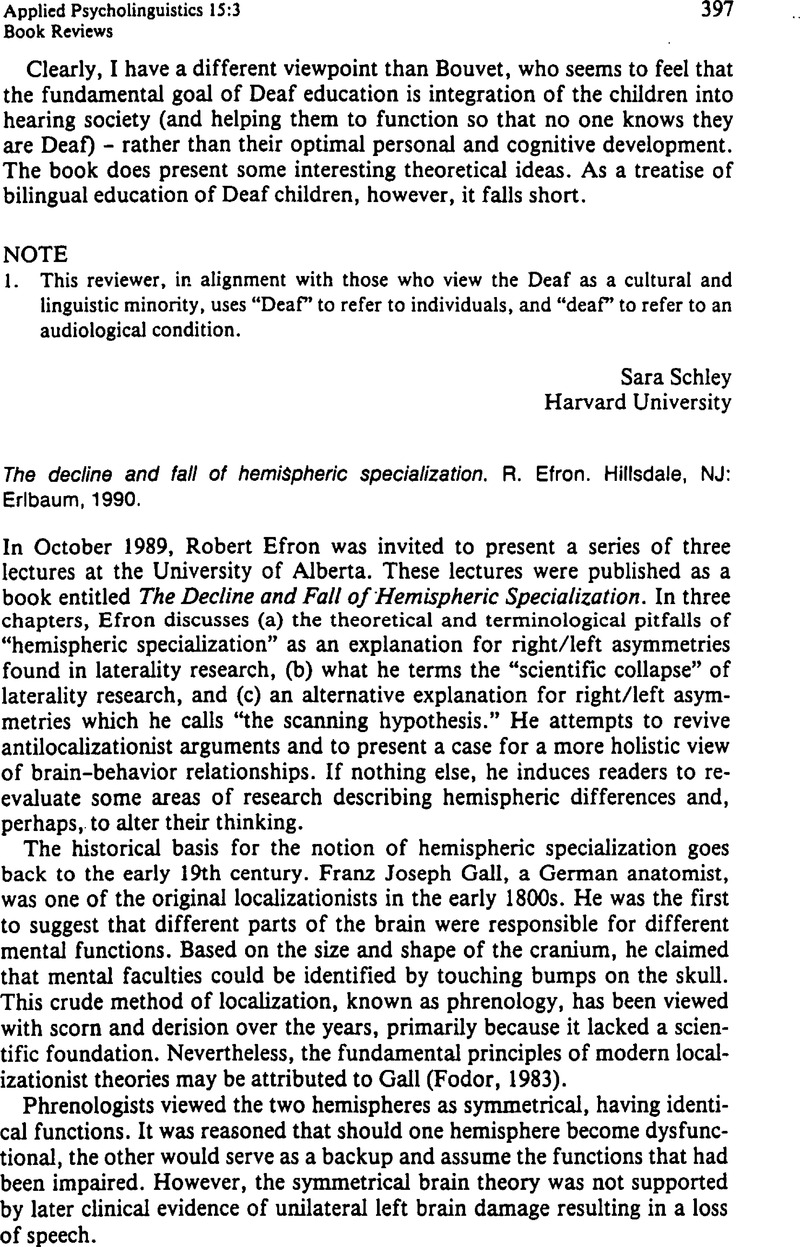No CrossRef data available.
Article contents
The decline and fall of hemispheric specialization. R. Efron. Hillsdale, NJ: Erlbaum, 1990.
Published online by Cambridge University Press: 28 November 2008
Abstract
An abstract is not available for this content so a preview has been provided. Please use the Get access link above for information on how to access this content.

- Type
- Book Reviews
- Information
- Copyright
- Copyright © Cambridge University Press 1994
References
REFERENCES
Berlin, C. I. (1972). Critical review of the literature on dichotic effects - 1970. In Reviews of Scientific Literature of Hearing (American Academy of Ophthalmology and Otolaryngology Monograph, 1971, pp. 80–90).Google Scholar
Berlin, C. I., & McNeil, M. R. (1976). Dichotic listening. In Contemporary issues in experimental phonetics. New York: Academic.Google Scholar
Berquier, A., & Ashton, R. (1992). Language lateralization in bilinguals: More not less is needed: A reply to Paradis (1990). Brain and Language, 43, 528–533.CrossRefGoogle Scholar
Broadbent, D. E. (1954). The role of auditory localization in attention and memory span. Journal of Experimental Psychology, 47, 191–196.CrossRefGoogle ScholarPubMed
Caplan, D. (1987). Neurolinguistics and linguistic aphasiology. New York: Cambridge University Press.CrossRefGoogle Scholar
Corballis, M. C. (1991). Left brain, right brain. Science, 251, 575–576.CrossRefGoogle ScholarPubMed
Geschwind, N. (1965). Disconnexion syndromes in animals and man. Brain, 88, 237–294.CrossRefGoogle ScholarPubMed
Geschwind, N., & Levitsky, N. (1968). Left-right asymmetries in temporal speech region. Science, 161, 186–187.CrossRefGoogle ScholarPubMed
Harrington, A. (1987). Medicine, mind, and the double brain. Princeton, NJ: Princeton University Press.CrossRefGoogle Scholar
Hellige, J. B. (1978). Visual laterality patterns for pure- versus mixed-list presentation. Journal of Experimental Psychology: Human Perception and Performance, 4, 121–131.Google ScholarPubMed
Kimura, D. (1961). Cerebral dominance and the perception of verbal stimuli. Canadian Journal of Psychology, 15, 166–171.CrossRefGoogle Scholar
Kimura, D. (1967). Functional asymmetry of the brain in dichotic listening. Cortex, 3, 163–178.CrossRefGoogle Scholar
Lecours, A. R. (1989). Paris 1908: The hot summer of aphasiology or a season in the life of a chair. Paper presented at the Academy of Aphasia, Santa Fe, NM.Google Scholar
Milner, B., Taylor, L. & Sperry, R. W. (1968). Lateralized suppression of dichotically presented digits after commissural section in man. Science, 161, 184–185.CrossRefGoogle ScholarPubMed
Sparks, R., & Geschwind, N. (1968). Dichotic listening in man after section of neocortical commissures. Cortex, 4, 3–16.CrossRefGoogle Scholar
Springer, S. P., & Deutsch, G. (1989). Left brain, right brain (3rd ed.). New York: W. H. Freeman.Google Scholar
Young, A. W., & Ellis, A. W. (1985). Different methods of lexical access for words presented in the left and right visual hemifields. Brain and Language, 24, 326–358.CrossRefGoogle ScholarPubMed


